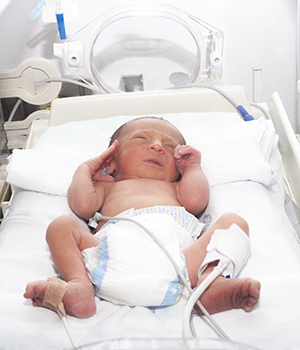Improving Healthcare Environments for Vulnerable Newborns
 Neonatal Intensive Care Units (NICUs) provide life-saving care for preterm babies. But, as with any urgent, intensive healthcare treatment, there is also the possibility for adverse long-term health concerns. One of the newest concerns for NICU babies is exposure to chemicals that can be hazardous to their health, specifically phthalates, a chemical softener for plastics.
Neonatal Intensive Care Units (NICUs) provide life-saving care for preterm babies. But, as with any urgent, intensive healthcare treatment, there is also the possibility for adverse long-term health concerns. One of the newest concerns for NICU babies is exposure to chemicals that can be hazardous to their health, specifically phthalates, a chemical softener for plastics.
Most U.S. children are exposed to phthalates through common every day sources, such as plastics in food packaging and toys. But NICU babies can be exposed to a higher level of phthalates at an especially vulnerable period of life. Now, the Icahn School of Medicine at Mount Sinai (ISMMS) and the Albert Einstein College of Medicine are leading a new study on phthalates exposure in the NICU.
“Phthalates are pervasive in the medical equipment used in the NICU,” explains Susan Teitelbaum, PhD, from ISMMS. “Exposure to phthalates, both in utero and in early childhood, has been associated with poor health outcomes, including respiratory illness, obesity and neurodevelopmental delays in children who were born full-term.”
The impact of phthalate exposure on the more than 300,000 premature babies admitted to the NICU every year—babies who are already at risk for cognitive delays, lung infections, and digestive disorders due to their early birth—is completely unknown.
“No one has investigated how the chemically intensive environment of the NICU may contribute to or exacerbate the health problems that are common among preterm infants, or how it may affect their long-term health,” says Judy Aschner, MD, from Einstein.
This is especially concerning given that the brain is going through a critical period of development during a premature baby’s first weeks of life. Adverse environmental experiences during this period of rapid cognitive programming may have life-long consequences.
Phthalates are not the only environmental exposure in the NICU that requires further study, Aschner adds. “Babies may also be exposed to metals in the NICU. We sometimes find traces of lead and aluminum in intravenous solutions or even in our blood supplies. Understanding the long-term effects of these exposures can help improve NICU environments.”
An unprecedented opportunity for change
To improve healthcare environments for these vulnerable newborns, Einstein and ISMMS are leading a first-of-its-kind study on the long-term impact of environmental exposures in the NICU: Environmental Influences on Child Health Outcomes: Developmental Impact of NICU Exposures (ECHO DINE). ECHO DINE is part of the ECHO Program, a seven-year initiative seeking to answer crucial questions about the effects of a broad range of early environmental influences on child health and development.
Specifically, the ECHO DINE study seeks to:
- Identify sources of phthalate exposures in preterm babies admitted to the NICU by studying urine samples collected from NICU babies. Analyzing each baby’s exposure alongside their length of stay and what medical equipment they encountered can help isolate the sources of exposure.
- Measure the impact of NICU-based phthalate exposure on health outcomes for those children. The urine samples used by ECHO DINE were collected in a previous study from children who are now ages 3 to 7. Parents of these children are completing surveys and physical assessments about their children on a variety of health indicators—including cognitive function, motor and communication skills, growth measurements, weight, height, social behaviors— that can help illustrate the long-term impacts of their original phthalate exposure.
NICHQ is tapping its project management and data analysis expertise to support the study, including collaborating with Einstein and ISMMS to develop data measures and working with the clinical sites to support data collection efforts.
ECHO DINE will continue to collect biospecimens (urine, hair, and baby teeth) from the same children between the ages of 3 to 12. This data will offer insight into the ongoing effects of environmental exposures on early childhood and long-term health. Moreover, by studying baby teeth, the study can date the exposure of trace metals during NICU stays, and, like with phthalates, analyze the impact of those exposures on the baby’s health outcomes during early and middle childhood.
Studying each child’s exposure alongside his or her health trajectory can illustrate how adverse environmental exposures in the NICU affect long-term health outcomes. These findings have the potential to change care practices and policies in the NICU.
“While there are rules about how much phthalates can go into children’s toys, phthalates in medical devices are not regulated at all,” says Aschner. “Every company does something different and there may be some phthalate mixtures that are more or less risky to a developing human being. By tracing adverse effects directly to their source, we can identify what plastics and specific equipment are linked with high phthalate exposure—that’s the importance of this study.”
The findings from the study also have the potential to help better identify health risks for babies who do reach term but are exposed to phthalates during pregnancy. Up until now, explains Teitelbaum, studies on the effects of this exposure have been limited.
Findings from the DINE study will join findings from the full ECHO Program, which encompasses studies on more than 50,000 children. Together, these research projects will help provide a more complete picture of how the environment influences children’s health outcomes at many different windows of susceptibility, from the prenatal period through adolescence.
“It’s gratifying to be part of what is truly groundbreaking work,” says NICHQ Senior Analyst Emily O’Donnell, ScD, MS. “The fact that we are collecting data points across such a diverse set of measures, over this extended time period, offers a really powerful and unique data set with which we can explore the research aims.”
